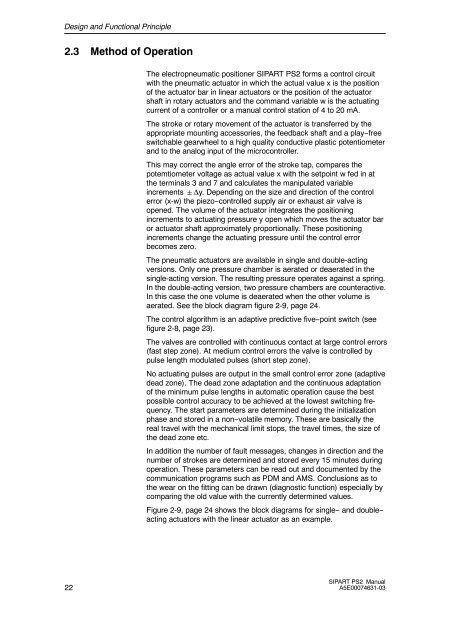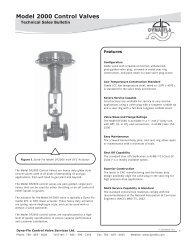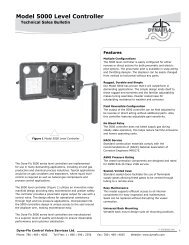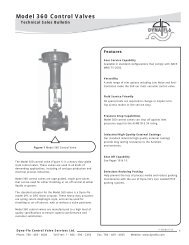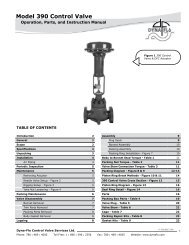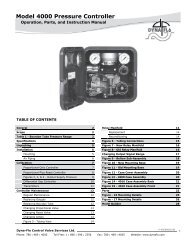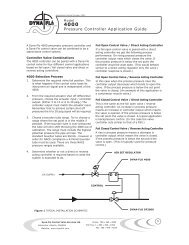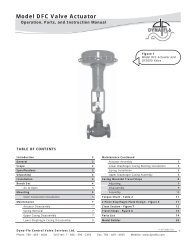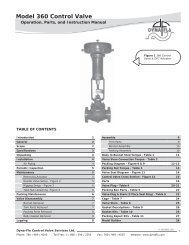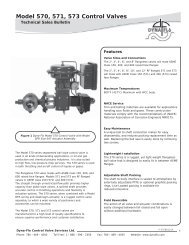view user manual (pdf) - dyna-flo control valves
view user manual (pdf) - dyna-flo control valves
view user manual (pdf) - dyna-flo control valves
You also want an ePaper? Increase the reach of your titles
YUMPU automatically turns print PDFs into web optimized ePapers that Google loves.
Design and Functional Principle<br />
2.3 Method of Operation<br />
The electropneumatic positioner SIPART PS2 forms a <strong>control</strong> circuit<br />
with the pneumatic actuator in which the actual value x is the position<br />
of the actuator bar in linear actuators or the position of the actuator<br />
shaft in rotary actuators and the command variable w is the actuating<br />
current of a <strong>control</strong>ler or a <strong>manual</strong> <strong>control</strong> station of 4 to 20 mA.<br />
The stroke or rotary movement of the actuator is transferred by the<br />
appropriate mounting accessories, the feedback shaft and a play--free<br />
switchable gearwheel to a high quality conductive plastic potentiometer<br />
and to the analog input of the micro<strong>control</strong>ler.<br />
This may correct the angle error of the stroke tap, compares the<br />
potemtiometer voltage as actual value x with the setpoint w fed in at<br />
the terminals 3 and 7 and calculates the manipulated variable<br />
increments Δy. Depending on the size and direction of the <strong>control</strong><br />
error (x-w) the piezo--<strong>control</strong>led supply air or exhaust air valve is<br />
opened. The volume of the actuator integrates the positioning<br />
increments to actuating pressure y open which moves the actuator bar<br />
or actuator shaft approximately proportionally. These positioning<br />
increments change the actuating pressure until the <strong>control</strong> error<br />
becomes zero.<br />
The pneumatic actuators are available in single and double-acting<br />
versions. Only one pressure chamber is aerated or deaerated in the<br />
single-acting version. The resulting pressure operates against a spring.<br />
In the double-acting version, two pressure chambers are counteractive.<br />
In this case the one volume is deaerated when the other volume is<br />
aerated. See the block diagram figure 2-9, page 24.<br />
The <strong>control</strong> algorithm is an adaptive predictive five--point switch (see<br />
figure 2-8, page 23).<br />
The <strong>valves</strong> are <strong>control</strong>led with continuous contact at large <strong>control</strong> errors<br />
(fast step zone). At medium <strong>control</strong> errors the valve is <strong>control</strong>led by<br />
pulse length modulated pulses (short step zone).<br />
No actuating pulses are output in the small <strong>control</strong> error zone (adaptive<br />
dead zone). The dead zone adaptation and the continuous adaptation<br />
of the minimum pulse lengths in automatic operation cause the best<br />
possible <strong>control</strong> accuracy to be achieved at the lowest switching frequency.<br />
The start parameters are determined during the initialization<br />
phase and stored in a non--volatile memory. These are basically the<br />
real travel with the mechanical limit stops, the travel times, the size of<br />
the dead zone etc.<br />
In addition the number of fault messages, changes in direction and the<br />
number of strokes are determined and stored every 15 minutes during<br />
operation. These parameters can be read out and documented by the<br />
communication programs such as PDM and AMS. Conclusions as to<br />
the wear on the fitting can be drawn (diagnostic function) especially by<br />
comparing the old value with the currently determined values.<br />
Figure 2-9, page 24 shows the block diagrams for single-- and double--<br />
acting actuators with the linear actuator as an example.<br />
22<br />
SIPART PS2 Manual<br />
A5E00074631-03


